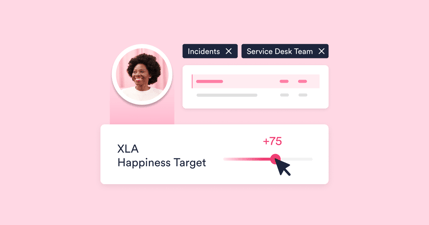You might have heard, “The king is dead; long live the king!” The same applies to service level agreements (SLAs) and eXperience level agreements (XLAs). Well, sort of. In this instance, the original king isn’t necessarily dead. However, there’s still a need to anoint a new one – with SLAs, and service level targets, not necessarily “shown the door” as experience level targets are brought in. In fact, our customers usually run both their traditional SLA-based metrics and new experience-based metrics in tandem until they’re confident that the latter provides better insight into IT performance and where improvements are needed.
As to why experience management data offers more than traditional SLAs, it’s best to start with the many issues organizations commonly experience (pardon the pun) with SLAs.
High-level examples of the common issues with traditional SLAs and metrics
So many things could be pointed out here that this could be a blog in itself – in fact, there’s a good one here.
Starting with a positive – the intentions of SLAs are often right no matter how poor the execution. The word “often” is carefully inserted in that sentence because it’s not always true. This issue is when SLAs are used for the wrong reasons (which leads to many other SLA issues).
Then there are issues with how they’re created. For example, there’s no or insufficient involvement by the customer(s). Or the metrics focus on what’s easy to measure rather than what’s most important to the customer(s).
Finally, there are issues with how they’re used or misused. For example, they’re only used to call out poor performance or are simply not used. Or the SLA metrics and targets are never refreshed when needed.
It’s a worrying list of example issues, and, importantly, many of these can still be present if not addressed when introducing experience measurement and management.
How end-user wants and needs have changed
In addition to these issues, it’s also important to consider how the environment within SLAs operate has changed. Businesses have far higher needs and expectations of IT. In particular, because of the various impacts of the global pandemic. For example, the need for rapid digital transformation affected both front-end and back-end operations. Plus, hybrid working requires new or improved technology services in the back office. Not only to ensure that work can still be done – via digital workflows – but also to meet end-user needs and expectations in their new work environments.
Employees are more reliant on technology than ever. This reliance extends the need for better services and employee experiences beyond the impact of consumerization (and employee consumer world experiences and expectations). And the only way to improve the employee experience is to monitor and manage it – with focused improvements as needed based on experience data.
Seeing the need for, and benefits of, experience management
Your organization is likely already investing in one form of experience management – external customer experience (CX). Realizing that was once a differentiator is now simply table stakes. While the price is still a key product/service selection factor for customers, so is the service experience – with customers willing to vote with both their feet and their wallets when the CX from a supplier doesn’t meet their expectations.
But this is solely the focus on, and measurement and improvement of, the external customer experience. There’s also the employee experience relative to the service delivery and support they receive from internal service providers such as your IT department. This requirement necessitates employee experience management and the experience data and insight it brings. Helping your organization understand what’s most important when improving their operations, service experience, and business outcomes.
Experience management and the IT service desk
Our research, in conjunction with our customers’ improvements, over the last decade, identified two key experience metrics that, when monitored and managed, lead to better employee experiences and business outcomes. These are:
- The happiness of employees – where end users are asked to rate their experience; this is done through a simple net promoter score (NPS) rating system.
- The employee’s lost time (which can be considered lost productivity); this is the end user’s estimation of the work time they lost waiting for IT service desk assistance.
These metrics measure the feedback from hundreds of thousands of IT end users, with the aggregate customer positions for these reported in our biannual Global IT Experience Benchmark report.
Reaping the benefits of experience management
If you haven’t already jumped to look at the Global IT Experience Benchmark report, then here are a few examples of how access to experience data and insights can help your IT department to make changes that better deliver against business needs:
- The most common cause of end-user IT dissatisfaction – this is hardware (laptops, computers, and mobiles), closely followed by enterprise applications
- The most important influence on what end-users think of IT – this is IT support services (for positive, neutral, and negative experiences)
- There are IT self-service portal use issues (for incidents) – end-users perceive they lose close to two hours more productivity when using self-service than when calling the IT service desk
- The most common cause of end-user IT support dissatisfaction with incident handling – this is “my ticket was not solved”
- The pain of ticket reassignment – each time a ticket is reassigned, end-user happiness decreases by nearly eight points, and end-users lose an average of 1 hour and 49 minutes of work time per reassignment.
These bullets just skim the surface of what experience data shows organizations and this data is for companies already investing in experience improvement. If you’d like to know how HappySignals can help your organization, please get in touch.




